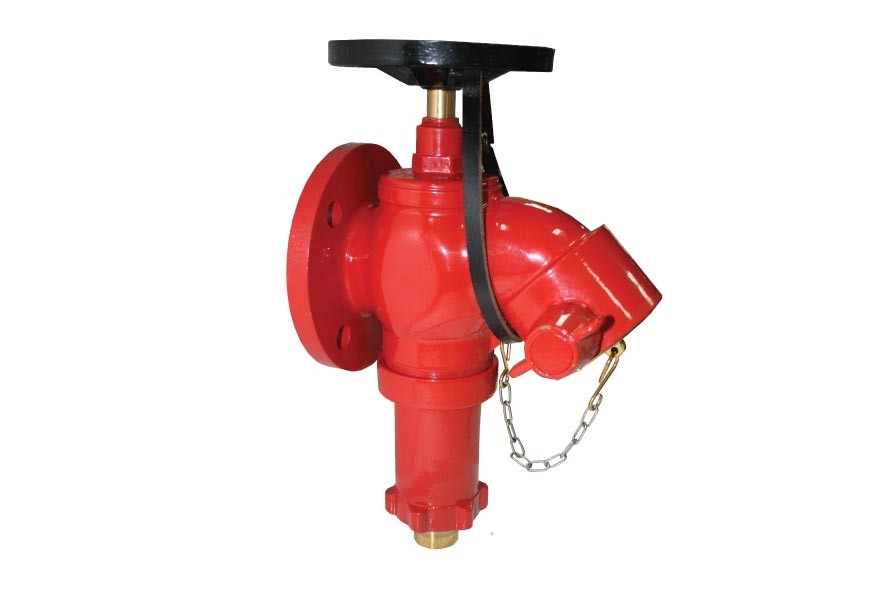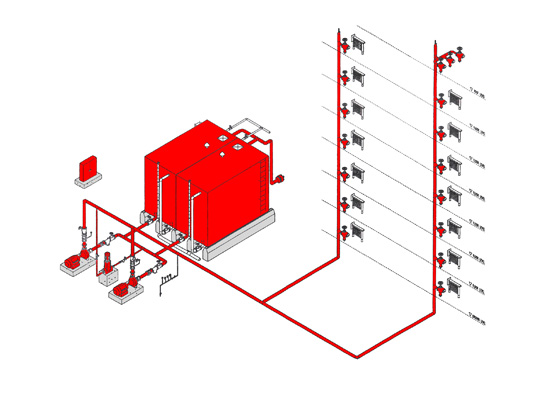 |
 |
PAGE UNDER DEVELOPEMENT!!!!!!!!!!!!!!!!!!!!!!!!!!!!
WET RISERS
Wet rising mains are fitted in tall buildings due to the excessive pressures required to pump water to high levels. A Wet riser is a supply system intended to distribute water to multiple levels or compartments of a building, as a component of its fire fighting systems.
They are advantageous to the fire service in two respects. Firstly they provide a fixed distribution system within the building that requires no fire service resources or equipment. Secondly it is designed as part of, and to maintain, the compartmentation of the building.
The designers or architects may opt for the superior protection of wet risers. Wet risers are a UK building regulations requirement in buildings over 50M ( over 60M up untill 2006)
Wet rising mains consist of vertical pipes similar to the dry rising main system with landing valves at each floor except the ground. The pipe system is connected to a permanent water supply normally a tank fed from the town mains. Duplicate automatic pumps, one duty and one standby supply this water to the pipe system.

The tanks are fitted with an automatic warning system to indicate a low water level.
At protracted incidents the wet rising main tank may need to be augmented and this can be acheived using conventional Fire appliances and additional water supplies (Hydrant, Open water etc)
Wet rising mains are designed to supply 1500 litres per minute for 45 minutes as a minimum.
Due to the height of the building and the pressures used, water pressure reduction valves are fitted to the outlets at each floor. Buildings constructed prior to 2006 will have outlet pressures of 4 to 5 Bars. Changes to BS 9990 in 2006 now recommend an outlet pressure of 8 Bars, this recommendation does not affect installations installed before this date.
Maintenance and Testing
Fire crews should be familiar with the layout and function of any dry riser in their risk area. If any buildinga are fitted with a Wet riser. then it is a special risk (PRM/SSRI). Specific and detailed information on the riser’s size, location and performance limits should be included within the risk data.
The annual testing and maintenance of both Dry and Wet Risers is the responsibility of the property owners or managing agents.
British Standard 5306: Part 1 1976 (Revised by BS9990) recommends that the system is visually inspected every 6 months and serviced annually to ensure that the equipment is ready for immediate use in an emergency. In addition, it is recommended that a ‘full wet test’ be carried out annually .
Riser failure
A defective or otherwise inoperative dry riser will seriously effect fire service operations. Riser failure can be brought about through many factors. An open outlet, restrictive blockage, mechanical failure of the pipework, vandalism and more recently theft of the inlet/outlet fittings.
At any time there is an issue with the correct functioning of a dry riser, the OIC must be informed immediately. He/she should make an immediate reassessment of available resources and, if required, order on additional appliances to maintain control of the incident. All reasonable steps should be taken to rectify a dry riser failure as a matter of urgency.
The most common reason for water failure or low delivery rates is an open outlet valve. Should this happen on a floor below the bridgehead this may be quickly remedied by deploying a crew to check these outlets.
If it is suspected that there is an outlet open above the bridgehead, then the OIC must risk assess how safe it will be to deploy a BA crew to rectify this problem. This risk assessment will include factors such as personal protection of BA crew, extent of fire travel, degree of smoke logging, integrity of fire and smoke compartmentation, location of incident in relation to stairwell, effectiveness of communications systems.
If the dry riser is deemed to be completely inoperative then the OIC must consider alternative ways to supply water to the incident floors/compartment. This may be a complex process as the OIC must endeavor to maintain the compartmentation of the building, as this is what protects and provides safe access and egress.
What may appear as a simple, and often suggested, solution to riser failure…"Laying hose lines up stairwells" will undoubtedly breach compartmentation and will lead to premature smoke logging of the stairwell should hose lines be extended into the affected area.
In single stairwell buildings consideration should be given to hauling hoses up externally. In high rise buildings this will be limited to 2 lengths of hose. These hoses should enter the building through windows/balconies on the fire floor as far away as possible from the compartment/flat that is involved. Use of an ALP/TL may be of assistance in this task.
In all instances where a riser fails or is inoperative a controlled and well resourced alternative must be initiated as a priority.